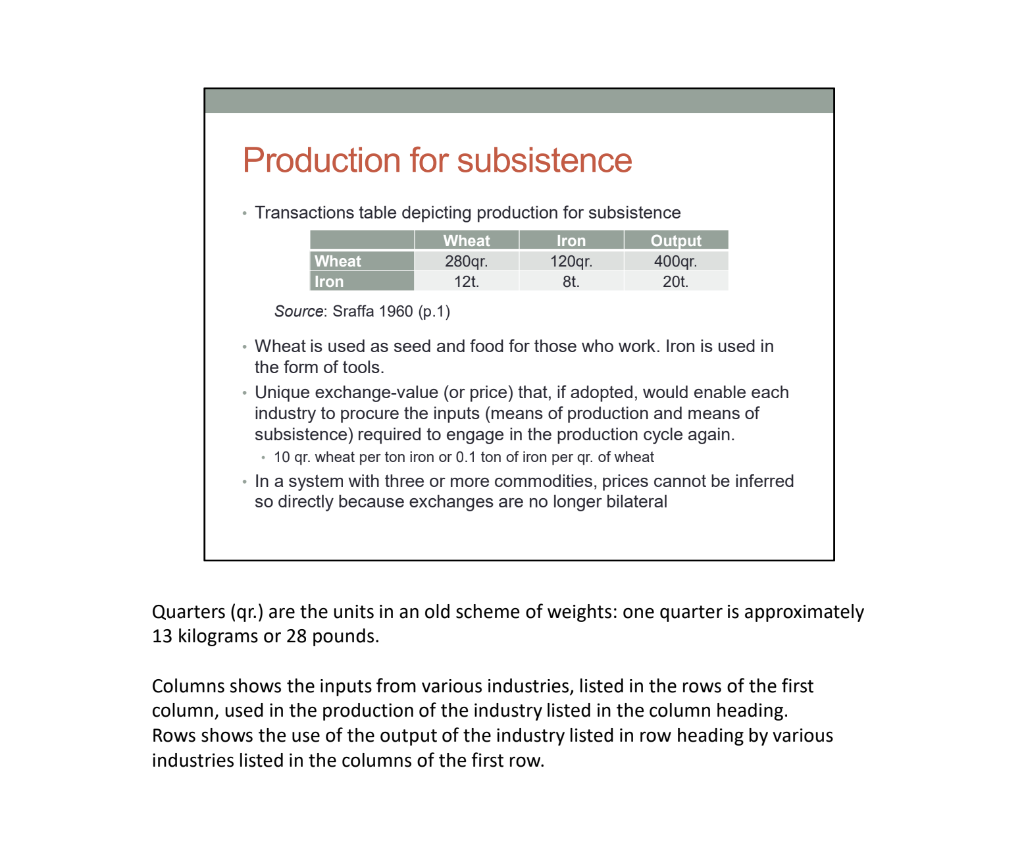Answered step by step
Verified Expert Solution
Question
1 Approved Answer
1. Following the numerical example from my slides, construct your own transactions table for a two-commodity economy. 2. Find the normal (equilibrium) price. 3. Using


1. Following the numerical example from my slides, construct your own transactions table for a two-commodity economy.
2. Find the normal (equilibrium) price.
3. Using one of the commodities as the numeraire, convert your transactions table in (a) to a table that is in values. Make sure that the total costs of production of each industry matches the total sales of that industry.
4. Compute the matrix.
5. Demonstrate why your matrix will have a maximum eigenvalue equal to 1 by using the relevant Perron-Frobenius theorem.
Production for subsistence - Simple economy that produces just enough to maintain itself - Assumptions: - Production takes place in annual cycles - Each industry produces a single commodity by means of labor, its own product and other commodities - No means of production last beyond the production cycle, i.e., there is only circulating capital and no fixed capital - There are no nonreproducible means of production that has to be paid for by the producers, i.e., no rent Production for subsistence - Transactions table depicting production for subsistence Source: Sraffa 1960(p.1) - Wheat is used as seed and food for those who work. Iron is used in the form of tools. - Unique exchange-value (or price) that, if adopted, would enable each industry to procure the inputs (means of production and means of subsistence) required to engage in the production cycle again. - 10 qr. wheat per ton iron or 0.1 ton of iron per qr. of wheat - In a system with three or more commodities, prices cannot be inferred so directly because exchanges are no longer bilateral Quarters (qr.) are the units in an old scheme of weights: one quarter is approximately 13 kilograms or 28 pounds. Columns shows the inputs from various industries, listed in the rows of the first column, used in the production of the industry listed in the column heading. Rows shows the use of the output of the industry listed in row heading by various industries listed in the columns of the first row. Production for subsistence - Simple economy that produces just enough to maintain itself - Assumptions: - Production takes place in annual cycles - Each industry produces a single commodity by means of labor, its own product and other commodities - No means of production last beyond the production cycle, i.e., there is only circulating capital and no fixed capital - There are no nonreproducible means of production that has to be paid for by the producers, i.e., no rent Production for subsistence - Transactions table depicting production for subsistence Source: Sraffa 1960(p.1) - Wheat is used as seed and food for those who work. Iron is used in the form of tools. - Unique exchange-value (or price) that, if adopted, would enable each industry to procure the inputs (means of production and means of subsistence) required to engage in the production cycle again. - 10 qr. wheat per ton iron or 0.1 ton of iron per qr. of wheat - In a system with three or more commodities, prices cannot be inferred so directly because exchanges are no longer bilateral Quarters (qr.) are the units in an old scheme of weights: one quarter is approximately 13 kilograms or 28 pounds. Columns shows the inputs from various industries, listed in the rows of the first column, used in the production of the industry listed in the column heading. Rows shows the use of the output of the industry listed in row heading by various industries listed in the columns of the first rowStep by Step Solution
There are 3 Steps involved in it
Step: 1

Get Instant Access to Expert-Tailored Solutions
See step-by-step solutions with expert insights and AI powered tools for academic success
Step: 2

Step: 3

Ace Your Homework with AI
Get the answers you need in no time with our AI-driven, step-by-step assistance
Get Started


